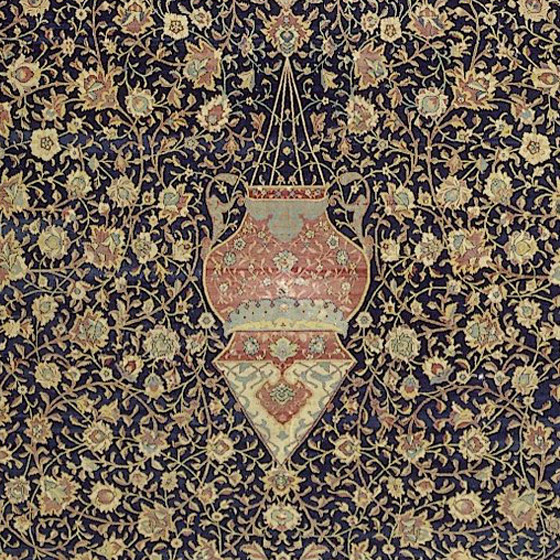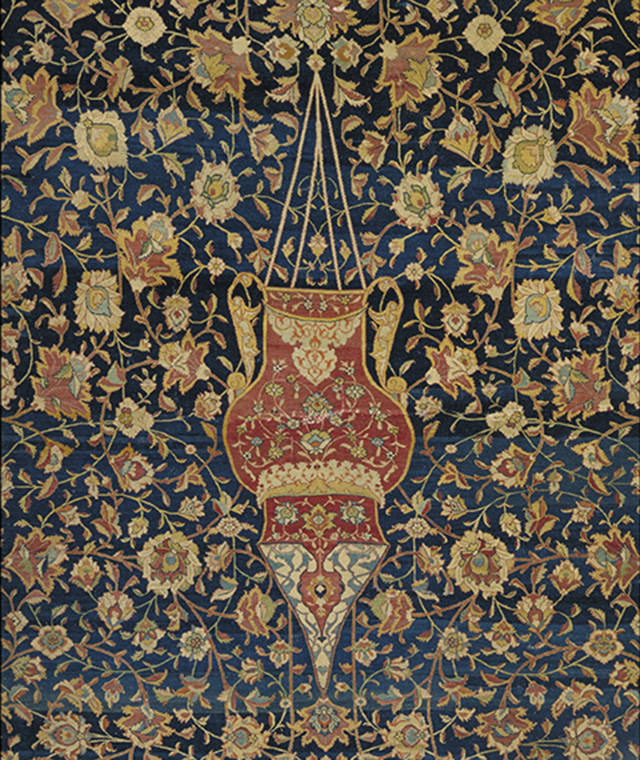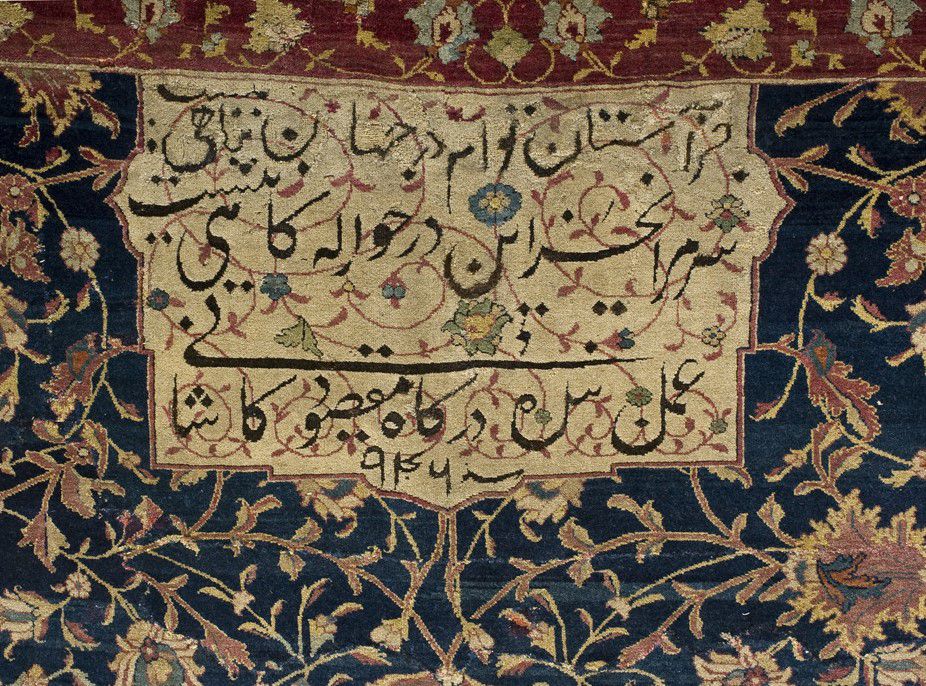
The Ardabil carpet, completed in 1539-40, is one of the largest and finest Islamic carpets in existence. It is also of great historical importance. It was commissioned as one of a pair by the ruler of Iran Shah Tahmasp between 1524 and 1576 for the shrine of his ancestor, Shaykh Safi al-Din, in the town of Ardabil in north-west Iran.
This most famous of Persian carpets has been the subject of endless copies ranging in size from small rugs to full scale carpets. There is an "Ardabil" at 10 Downing Street and even Hitler had an "Ardabil" in his office in Berlin. The famous 19th century English textile designer, poet, novelist, translator, and socialist activist William Morris described it as:
"A remarkable work of art ... the design is of singular perfection... its size and splendor as a piece
of workmanship do full justice to the beauty and intellectual qualities of the design."
| Name | Ardabil |
| Size (feet) | 34'5 x 17'5 |
| Size (m) | 10,5 m x 5,3 m |
| Fabrication | Handknotted |
| Knot | Persian (Senneh) - Asymmetrical Knot, 340 knots per square inch |
| Pile | Woollen pile, on silk warp and weft |
| Warp | Undyed silk. 35 threads per square inch |
| Origin | North West Iran |
| Age | 16th century (1539-1540) |
| Field Color | Shades of blue, 3 shades of red, yellow, green, black and white |
| Border Color | Shades of blue, 3 shades of red, yellow, green, black and white |
Brief History of the Ardabil
The Ardabil has a rich, exquisitely detailed and organized design in which a deep indigo field is covered with delicate, intricate floral tracery; a central medallion. The composition of the carpets is inspired by the mosque plan of Cheikh Safi, the ancestor and founder of the Safavides. The entire composition presents the illusion of a heavenly dome with lamps refelcted in a pool of water full of floating lotus blossoms. No human or animal figures appear, as befits a carpet intended for a mosque, altough they can be found on other islamic textiles used un secular contexts, both earlier or later.
Completed during the rule of the Safavid Shah Tahmasp I in the mid-16th century the carpets are considered some of the best of the classical Persian school of carpet creation. There is no record of where the carpets were made - Tabriz and Kashan are considered the most likely places - nor any proof, except for their longtime moniker, that the carpets actually came from the Shrine at Ardabil. After becoming heavily worn at the mosque in Ardabil, Iran, they were sold in 1890 to a British carpet broker who restored one of the carpets using the other and then resold it to the Victoria and Albert Museum. William Morris, then an art referee for the V&A, was instrumental in the acquisition.
The second "secret" carpet, smaller, now borderless, and made up from the remaining usable sections, was sold to American businessmen Clarence Mackay and was exchanged by wealthy buyers for years. Passing through the Mackay, Yerkes, and De la Mare art collections, it was eventually revealed and shown in 1931 at an exposition in London. American industrialist J. Paul Getty saw it, and bought it from Lord Duveen for approximately $70,000 several years later. Getty was approached by agents on behalf of King Farouk of Egypt who offered $250,000 so that it could be given as a wedding present. Getty later donated the carpet to the Museum of Science, History, and Art in the Exposition Park in Los Angeles. This most famous of Persian carpets has been the subject of endless copies ranging in size from small rugs to full scale carpets. There is an 'Ardabil' at 10 Downing S and Hitler had an 'Ardabil' in his office in Berlin.

Materials & Techniques
The exact knot-count of the Ardabil carpet varies throughout its structure, as is typical, and the given count of 340 knots per inch (equivalent to 5,472/dm2) is therefore an average value. The Los Angeles Ardabil carpet in turn has been recorded to hold an average of 350 knots per square inch: the two carpets therefore have roughly the same knot-count. This near-parity supports the accepted proposal that the two carpets were woven by the same team at the same time.

Medallion
Looking down at the precisely symmetrical central medallion, one sees a garden-like nature to the carpet. According to most scholars, this suggests that the innermost part of the medallion is a garden pool. However some scholars dispute this saying that the design consists of a central sunburst medallion, representing the inside of a dome, surrounded by 16 pendants.

Two Mosque Lamps
Larger Lamp
Two mosque lamps of different sizes are suspended from the carpets sunburst medallion along its axis. Art historians have debated the meaning of each lamp for centuries. Some claim that the lamps were inserted to create a perspective effect. In other words, the designer wanted them to appear equal in size when viewed from the end of the carpet at the room's threshold. However, there is no evidence for the use of this type of perspective in Iran in the 1530s. Other historians believe that they were included to mimic lamps found in mosques and shrines, helping the viewer to look deeply into the carpet below them and above, to the ceiling where similar lamps would hang, creating visual unity within the shrine.

Smaller Lamp
The direction of the pile shows that the weavers began at the end with the smaller lamp.
Just like the bigger lamp, the small lamp has a flat shape rather than as three-dimensional object shape. Also, it features a small deliberate flaw in its design, reflecting the belief that perfection belongs to God alone.
Some people think that the smaller lamp was done to create a perspective effect – if you sat near it, both lamps would appear to be the same size.

Field Flowers & Blossoms
The rich blue background is covered with leaves and flowers attached to delicate stems that spread over the whole field. The interlaced vines follow curved linear patterns of spiral, oval, paisley and lozenge shapes, with barely a straight line anywhere to be found. A long, sweeping course will pull your eye halfway down the carpet's length, then splinter in half in a dozen directions, like fireworks that burst into progressively smaller volleys of color. The floral patterns create marvelous temporal illusions. The blossoms are a typical Sasanian lotus palmette crossed with Chinese peonies, some in full bloom and others barely emerging from buds.

Border Flowers
Chinese-style clouds animate the straight-edged floral borders. This flower, known as the Lotus Flower is found 16 times throughout the border of the Ardabil carpet. The decor of its edge is very elaborate.
In a broad sense, in the Persian culture, floral designs are taken to represent spring, and all of the allegory associated with rebirth and fertility. But each flower also bears meaning. The lotus flowers throughout its border stand for rebirth and the peonies, spread through its field, signify power.

Inscription & Signature
Both Ardabil carpets carry a four-line inscription placed at one end positioned between two triangles towards one of the vertical borders. It is said to be by a poem by the famous Persian poet Hafiz. It is signed by its master weaver Maqsoud Kachani and dated 946/1539-40 after Christ.
The epigraph is a double illusion destined to showcase in one part the master weavers recognition towards his protector who ordered the creation of the rug and expressing in second part, the devotion of the weaver towards Chah Tahmasp and god his protector.
| Text in Farsi | English Translation |
|
جز استان توام در جهان پناهی نیست " سرمرا بجز این در حواله گاهی نیست "عمل بنده درگاه مقصود کاشانی |
"I have no refuge in the world other than thy threshold. There is no protection for my head other than this door. The work of the servant of the court Maqsud of Kashan in the year 946." |
Sources: VICTORIA & ALBERT MUSEUM. Carpet - The Ardabil Carpet. [on line]. http://collections.vam.ac.uk/item/O54307/the-ardabil-carpet-carpet-unknown/ [page consulted on 11/01/2019]; LACMA (LOS ANGELES COUNTY MUSEUM). Ardabil Carpet. [on line]. https://collections.lacma.org/node/230372 [page consulted on 11/01/2019]; Print.; Bashir, S. (11/01/2019). Personal interview.; Without prejudice to official usage.
Place An Order
We can reproduce the Ardabil carpet shown on this page in the size and colors of your choice. For more information, feel free to call us at +1-514-735-1958 from Monday to Saturday between 10 am and 5 pm Eastern standard time or feel free to e-mail us at [email protected]


 Tapis d'Orient Bashir | Bashir Persian Rugs
Tapis d'Orient Bashir | Bashir Persian Rugs
 @tapisbashir
@tapisbashir
 @bashircarpets
@bashircarpets
 @bashircarpets
@bashircarpets